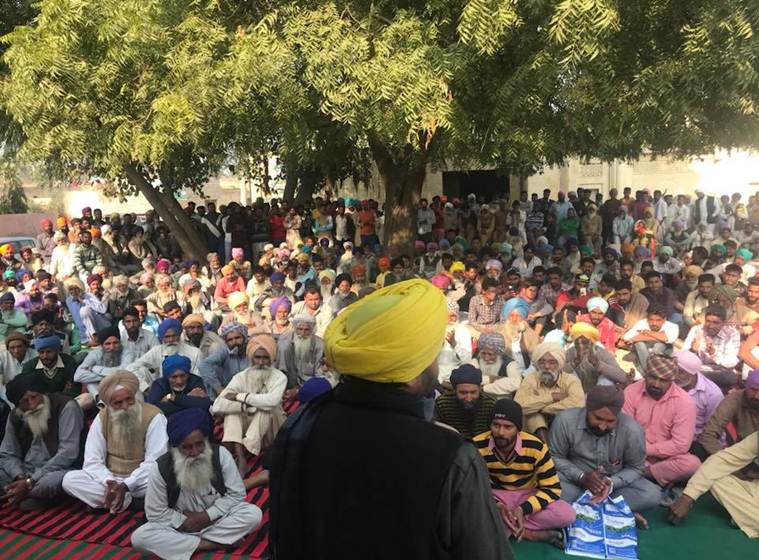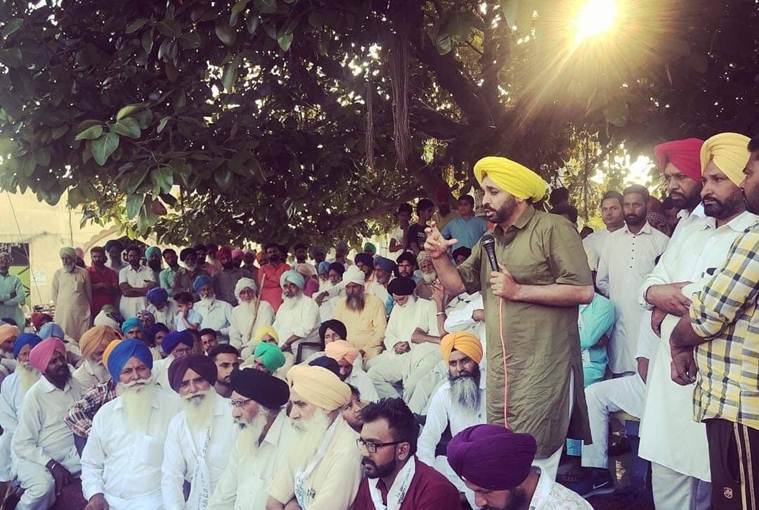
“Rahe vasenda pind mera, vasey ethon di satth; har samay bazurgan da, sar tey rahey hatth. (My village and its satth should remain prosperous; the elderly should always keep blessing and guiding us).” Part of the Punjabi lore, this old saying is steering AAP’s Bhagwant Mann to tap into Pind Di Satth — a common place where villagers gather for community discussions.
Traditionally held under a tree located at central point in the village with a cemented platform around it, or outside a big darwaaza (door), or more recently under a shed, the ‘Satth’ has been a spot for villagers in Punjab to assemble and speakers to address them on vital issues.
The relationship between politicians and ‘Pind Di Satth’ in Punjab has been an old one. While the interactions have shrunk with Satth slowly vanishing from villages, a special campaign series ‘Pind Di Satth Ch’ by AAP’s Sangrur MP and candidate Bhagwant Mann has brought the tradition alive this election season.
Addressing ‘Pind Di Satth’ gatherings in at least 15-20 villages a day, even continuing till late night as village youths flash torches of their mobile phones to see him, Mann arrives riding pillion on a motorbike with a cavalcade of his supporters on bikes.
Shaking hands with villagers and clicking selfies with his ‘fans’, he climbs the cemented platform under a tree at village Maur Nabha of Sangrur amid loud cheers of ‘Inquilab Zindabad’.

He begins his address with a sharp attack on CM Amarinder Singh: “Raje Maharaje raaj karan atey janta bhukki mare. Eh lamba samaa nahi chalda doston..Saadi gareeb maanvan behna chuleyaan ch fukkan maar maar ke annian hogian.. ki shayad mere putt nu, dhee nu naukri milje.. nahi.. eh kehende si assi ghar ghar naukri davange.. main kehna Captain saab.. ghar ghar na si.. ikk ghar chadd ke dedo naukri.. shuruaat taan kar lo.. helikaaptar tey langh jaande hai.. aah langhaya huney etho di.. Captain hi si oh.. Helikaaptar chon garreeb dey chulhey di agg nazar ni aundi. Main ethe sirf chutkley sunuan ni aaya, sach bolan aaya haan (Kings rule and people die of hunger, this doesn’t work for long. Our poor mothers and sisters are getting blind lighting stoves with a hope that their sons or daughters will get jobs. This government said they will give a jobs in every household. But I say to the CM that give a job in every second home. Start somewhere at least. Just now his helicopter passed from above….I am not here just to crack jokes but to tell the truth),” says Mann.
As the mood during his ‘Pind Di Satth’ goes somber, Mann doesn’t shy away from stepping among the villagers, consoling old women who start wiping water in their eyes with their dupatta, after hearing his speech.
He continues: “Tussi meri duty Parliament ch laayi si.. Modi nu paseena aa jaanda si jado main puchda si ‘Bataiye Modi ji.. ache din kab aane wale hain? (You people sent me to Parliament. PM Narendra Modi used to sweat when I asked him there that when are ache din coming?).”
Mann’s Pind Di Satth is not just a revival of tradition in the villages but also packaged in a way that they reach social media savvy youths and each session is shared on his Facebook page with hashtag #PindDiSatthCh (in Punjabi).
In the middle of his address at Pind Di Satth, he asks people, “Smart phone mil gaye?”, “Naukriyaan mil gaiyaan?” As they respond in negative to his questions, he adds shaking his hand: “Koi na fir tussi vi 19 nu ehdaan hi kar dio.”
Sukhwinder Singh, a PhD scholar who has his doctoral research on the topic ‘Pind Di Satth: Swaroop Tey Roopantar’ (How Satth in villages of Punjab has evolved and transformed over time), says, “Satth used to be a very powerful tool in villages of Punjab. For instance, if police used to come in village to arrest someone, first they would go to Satth knowing they will get every detail about that person from elderly sitting there. But with time the concept has changed and Satth has now become virtual with people discussing on Facebook, Twitter and other social media sites instead of gathering at a common place in village. But the difference is that virtual Satth on social media is full of lies and manipulations with incorrect facts whereas in real Satth, it is more about facts and elderly who sit there to keep an eye.”
“In Punjab, politicians have an old relationship with Satth. Veteran leaders like Parkash Singh Badal used to attend Satth and discuss people’s issues with them but hardly young politicians do that now. Motive is show that they are one of their own. Currently, it is AAP leaders like Bhagwant Mann and Dr Dharamvira Gandhi who are going among the people and discussing issues with them as one of their own. In fact, one of the biggest reasons for Mann’s success and fan-following is because he is going among them all the time — day and night.”
Dr Surjit Patar, Padma Shri Punjabi poet and chairman Punjab Arts Council, says, “Satth is dying in villages now because people don’t have time to sit together and discuss their issues. It is still alive in some villages however. Now, people have other sources of entertainment. Community discussions should always be encouraged and Satth is an oldest form of such discussions in Punjab.”
And now with time, the saying in Punjab has changed to this: “Ajj kon jaanda satth ki, tey panchayat ki hundi; buddha peepal ki, tey pind da thada ki? (In today’s times, who knows what is satth, what is the importance of that old peepal tree and the platform under it…).”